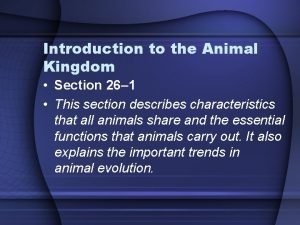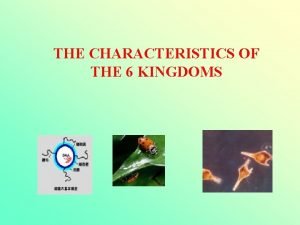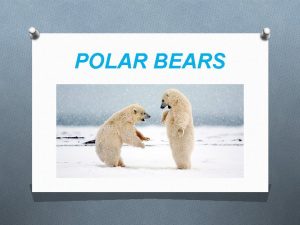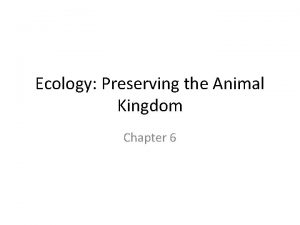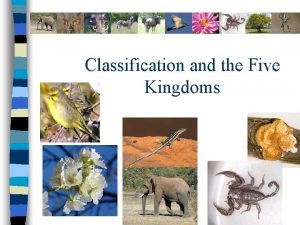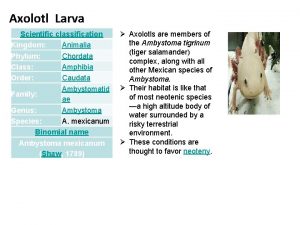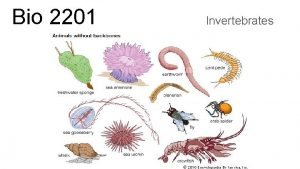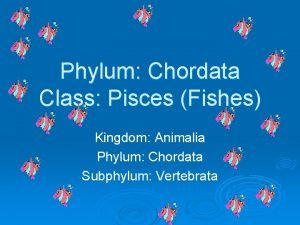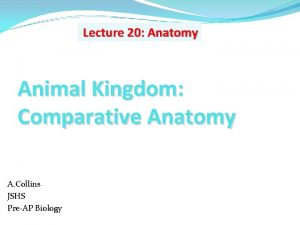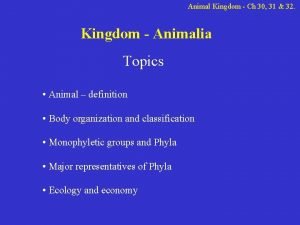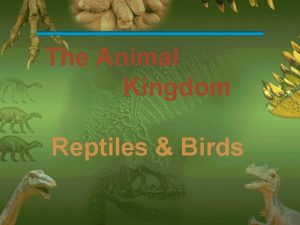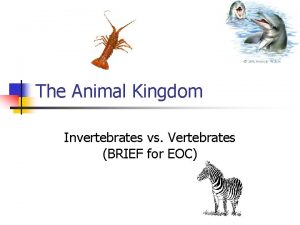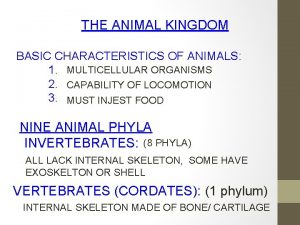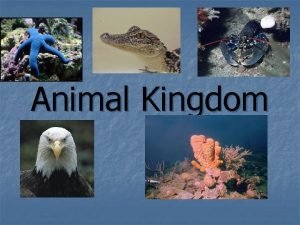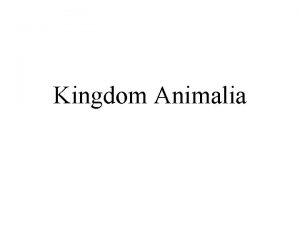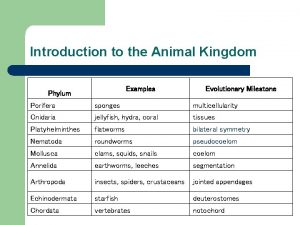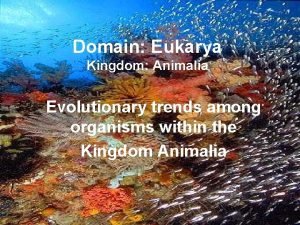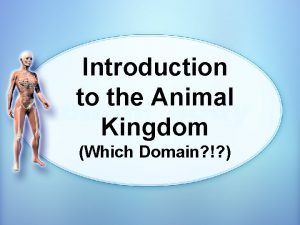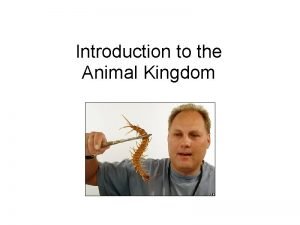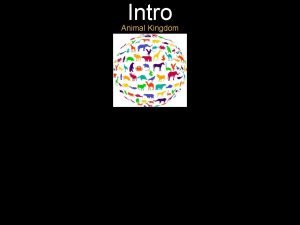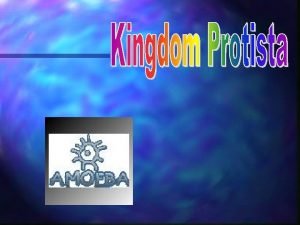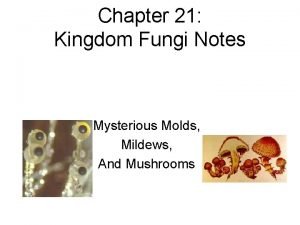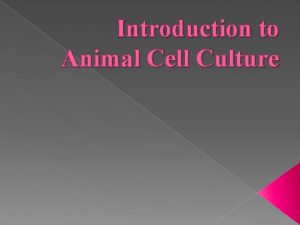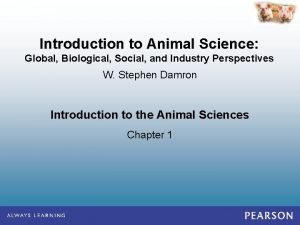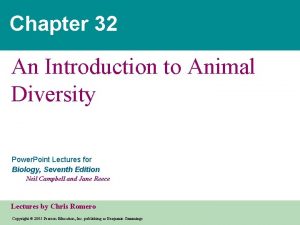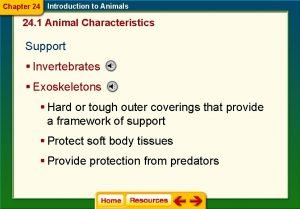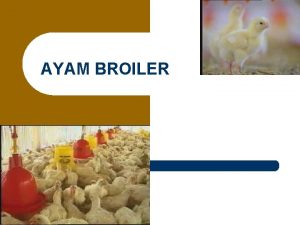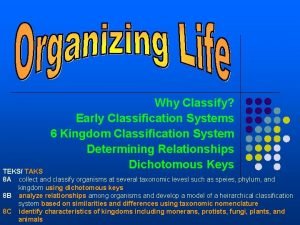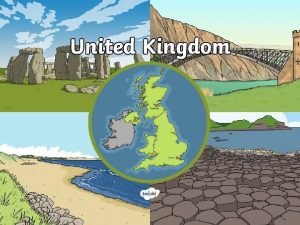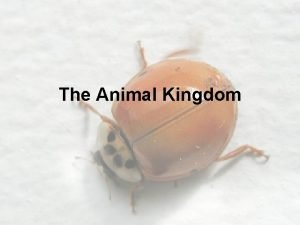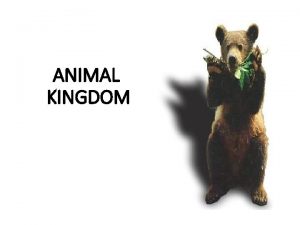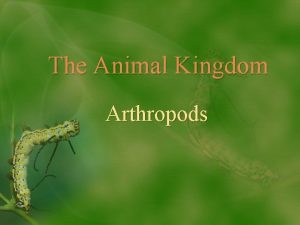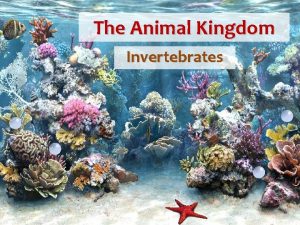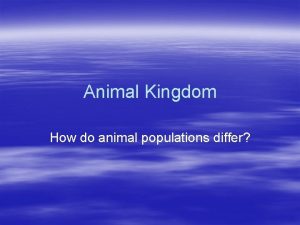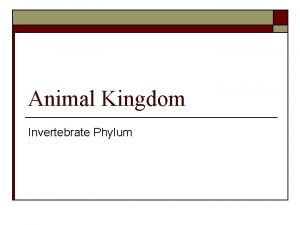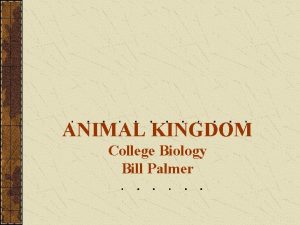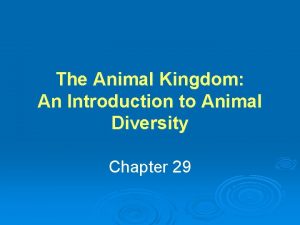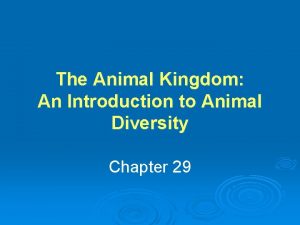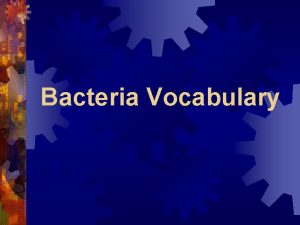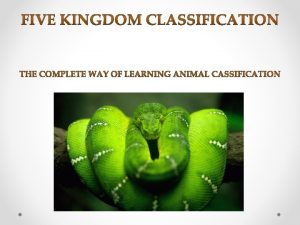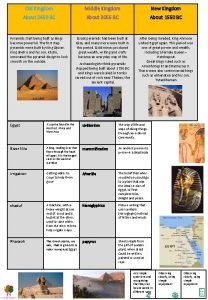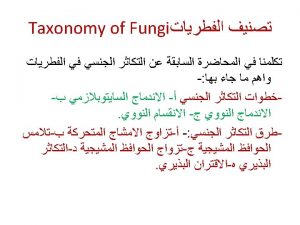Introduction to the Animal Kingdom Of all the















































































































- Slides: 111

Introduction to the Animal Kingdom • Of all the kingdoms of organisms, the animal kingdom is the most diverse in appearance • Some animals are so small that they live on or inside the bodies of other animals • Others are many meters long and live in the depths of the sea • They may walk, swim, crawl, burrow, or fly—or not move at all • As you will see, each major group, or phylum, has its own typical body plan

What Is an Animal? • All members of the animal kingdom share certain characteristics • Animals are all heterotrophs, meaning that they obtain nutrients and energy by feeding on organic compounds from other organisms • Animals are multicellular, or composed of many cells • The cells that make up animal bodies are eukaryotic, meaning that they contain a nucleus and membrane-bound organelles • Unlike the cells of algae, fungi, and plants, animal cells do not have cell walls • Animals, members of the kingdom Animalia, are multicellular, eukaryotic heterotrophs whose cells lack cell walls

What Is an Animal? • The bodies of most animals contain tissues – Recall that a tissue is a group of cells that perform a similar function • Animals have epithelial, muscular, connective, and nervous tissues • Epithelial tissues cover body surfaces • The epithelial cells that line lung surfaces, for example, have thin, flat structures through which gases move in and out easily • The cells of muscle tissue contain proteins that enable the cells to contract, moving parts of animals' bodies • Connective tissue, such as bone and blood, support an animal's body and connect its parts • Cells embedded in bone tissue produce minerals that give strength and hardness to bone • Nervous tissue is composed of nerve cells, which have threadlike projections that act like telephone wires to carry information throughout the body

What Is an Animal? • Over 95 percent of all animal species are often grouped in a single, informal category: invertebrates – This group is defined in an odd way—by describing a characteristic that its members do not have – Invertebrates are animals that do not have a backbone, or vertebral column • They range in size from microscopic dust mites to the giant squid, which is more than 20 meters in length • They include groups as diverse as sea stars, worms, jellyfishes, and insects • The other 5 percent of animals, including fishes, amphibians, reptiles, birds, and mammals, are called vertebrates, because they have a backbone vertebrates

KINGDOM ANIMALIA • • Multicellular Eukaryotic Heterotrophic No cell walls

INVERTEBRATES • Animals without backbones • Approximately 97% of all animals

What Animals Do to Survive • Animals carry out the following essential functions: feeding, respiration, circulation, excretion, response, movement, and reproduction • Over millions of years, animals evolved in a variety of ways that enable them to do this • The study of the functions of organisms is called physiology • The structure, or anatomy, of an animal's structure, or anatomy body enables it to carry out physiological processes

What Animals Do to Survive • Many body functions help animals maintain homeostasis, or a stable internal environment • Homeostasis is often maintained by internal feedback mechanisms • Most of these mechanisms involve feedback inhibition, in which the product or result of a process stops or limits the process • For example, when a dog becomes too hot, it pants • Panting releases heat, and the animal's body temperature decreases

Feeding • Most animals cannot absorb food; instead, they ingest (or eat) it • Animals have evolved a variety of ways to feed • Herbivores eat plants; carnivores eat other animals; and omnivores feed on both plants and animals • Detritivores feed on decaying plant and animal material • Filter feeders are aquatic animals that strain tiny floating organisms from water

Feeding • Animals can also form symbiotic relationships, in which two species live in close association with each other • A parasite for example, is a type of symbiont that lives within or on another organism, the host – The parasite feeds on the host, harming it

Respiration • Whether they live in water or on land, all animals respire, which means that they take in oxygen and give off carbon dioxide • Because of their very simple, thin-walled bodies, some animals can rely on the diffusion of these substances through their skin • Most other animals, however, have evolved complex tissues and organ systems for respiration

Circulation • Many small aquatic animals, such as some aquatic worms, rely solely on diffusion to transport oxygen, nutrient molecules, and waste products among all their cells – Diffusion is sufficient because these animals are only a few cell layers thick • Larger animals, however, have some kind of circulatory system to move materials around within their bodies

Excretion • A primary waste product of cells is ammonia, a poisonous substance that contains nitrogen – A buildup of ammonia and other waste products would kill an animal • Most animals have an excretory system that either eliminates ammonia quickly or converts it into a less toxic substance that is removed from the body • By eliminating metabolic wastes, excretory systems help maintain homeostasis

Response • Animals respond to events in their environment using specialized cells called nerve cells • In most animals, nerve cells hook up together to form a nervous system • Some cells, called receptors, respond to sound, light, and other external stimuli • Other nerve cells process information and determine how the animal responds • The arrangement of nerve cells in the body changes dramatically from phylum to phylum

Movement • Some adult animals stay attached to a single spot • Most animals, however, are motile, meaning they can move • But both stick-in-the-muds and jet-setters usually have either muscles or musclelike tissues that generate force by becoming shorter • Muscle contraction enables motile animals to move around, usually by working in combination with a support structure called a skeleton • Muscles also help even sedentary animals feed and pump water and fluids through their bodies

Reproduction • Most animals reproduce sexually by producing haploid (monoploid) gametes • Sexual reproduction helps create and maintain genetic diversity in populations • It therefore helps improve species' abilities to evolve when the environment changes • Many invertebrates can also reproduce asexually • Asexual reproduction produces offspring that are genetically identical to the parent. It allows animals to increase their numbers rapidly

Trends in Animal Evolution • Your survey of the animal kingdom will begin with simple forms and move through more complicated ones • These different phyla are related to one another by a common evolutionary heritage • The diagram at right shows our most current understanding of phylogenetic relationships among groups of living animals • A comparison of the groups in the diagram shows important trends in animal evolution • Complex animals tend to have high levels of cell specialization and internal body organization, bilateral body symmetry, a front end or head with sense organs, and a body cavity • In addition, the embryos of complex animals develop in layers

Animal Cladogram • • This diagram illustrates phylogenetic, or evolutionary, relationships among major groups of animals Groups shown close together, such as echinoderms and chordates, are more closely related than groups that are shown farther apart, such as echinderms and cnidarians During the course of evolution that produced these different groups, important traits evolved Animals that are more complex typically have specialized cells, bilaterally symmetry, cephalization, and a body cavity

Animal Cladogram

Cell Specialization and Levels of Organization • As animals have evolved, by natural selection and other evolutionary processes, their cells have become specialized to carry out different functions, such as movement and response • Large animals need greater efficiency in body processes than do very small animals • Unicellular organisms, such as amoebas, move nutrients and waste products directly across their cell membranes • In multicellular organisms such as animals, however, each cell type has a structure and chemical composition that enable it to perform a specialized function • Groups of specialized cells form tissues • Tissues join together to form organs and organ systems—all of which work together to carry out a variety of complex functions

ANIMAL DEVELOPMENT • • Zygote: fertilization of egg by sperm Cleavage: mitosis of the zygote Blastula: hollow ball of cells Gastrula: – Cell differentiation begins • Germ layers: cells that originate in the embryo and become specific structures in the adult – Ectoderm: becomes epidermis/nervous system – Mesoderm: becomes the muscles/bones/reproductive organs – Endoderm: becomes the digestive system – Cells begin to fold inward

ANIMAL DEVELOPMENT

Early Development • During early development, the cells of most animal embryos differentiate into three layers called germ layers • The cells of the endoderm, or innermost germ layer, develop into the linings of the digestive tract and much of the respiratory system • The cells of the mesoderm, or middle layer, give rise to mesoderm muscles and much of the circulatory, reproductive, and excretory organ systems • The ectoderm, or outermost layer, gives rise to sense ectoderm organs, nerves, and the outer layer of the skin

ANIMAL DEVELOPMENT

Early Development • • • Animals that reproduce sexually begin life as a zygote, or zygote fertilized egg The figure at right shows patterns of embryology, or development of the embryo after fertilization The zygote undergoes a series of divisions to form a blastula, which is a hollow ball of cells The blastula folds in on itself, forming a single opening called a blastopore The process of blastopore formation changes a simple ball of cells—similar to an inflated balloon —into an elongated structure with a tube inside, as if you were holding the balloon and pushing your thumbs toward the center

Early Development of an Animal Embryo • During the early development of animal embryos, cells divide to produce a hollow ball of cells called a blastula • An opening called a blastopore forms in this ball • In protostomes, the blastopore develops into the mouth • In deuterostomes, the blastopore forms an anus • What cell layer lines the digestive tract in both protostomes and deuterostomes?

Early Development of an Animal Embryo

Early Development • The blastopore leads into a central tube that runs the length of central tube the developing embryo • This tube becomes the digestive tract and is formed in one of two ways: – A protostome is an animal whose mouth is formed from the blastopore • Most invertebrate animals are protostomes – A deuterostome is an animal whose anus is formed from the blastopore • The anus is the opening through which wastes leave the digestive tract – The mouth is formed second, after the anus (deuterostome means “second mouth”) • Echinoderms and all vertebrates are deuterostomes – This similarity in embryology may indicate that vertebrates have a closer evolutionary relationship to echinoderms than to other invertebrates

BODY SYMMETRY • Asymmetrical: no body design • Spherical Symmetry: – Can be divided into equal halves by passing a plane in any direction through a central point • Radial Symmetry: – Can be divided into similar halves by passing a plane through the longitudinal axis of the animal • Bilateral Symmetry: – Can be divided into similar halves by only one specific plane passing through the longitudinal axis

BODY SYMMETRY

Body Symmetry • With the exception of sponges, every kind of animal exhibits some type of body symmetry in its anatomy, or body structure • Many simple animals, such as the sea anemone shown on the left in the figure at right, have body parts that repeat around the center of the body – These animals exhibit radial symmetry, similar to that of a bicycle wheel, in which any number of imaginary planes can be drawn through the center, each dividing the body into equal halves

Body Symmetry • • • In animals with bilateral symmetry, such as the crayfish in the figure at right, only a single imaginary plane can divide the body into two equal halves Animals with bilateral symmetry have left and right sides They also usually have front and back ends and upper and lower sides The anterior is the front end, and the posterior is the back end The dorsal is the upper side, and the ventral is the lower side

Radial and Bilateral Symmetry • Animals with radial symmetry, such as the sea anemone, have body parts that extend from a central point • Animals with bilateral symmetry, such as the crayfish, have distinct anterior and posterior ends and right and left sides • How many planes of symmetry does the crayfish have?

BODY SYMMETRY • • • Anterior: front Posterior: back Dorsal: top Ventral: bottom Lateral: side

Radial and Bilateral Symmetry

Body Symmetry • An anatomy with bilateral symmetry allows for segmentation, in which the body is constructed of many repeated and similar parts, or segments • Animals with bilateral symmetry, such as worms, insects, and vertebrates, typically have external body parts that repeat on either side of the body • The combination of bilateral symmetry and segmentation is found in two of the most successful animal groups— arthropods and vertebrates • Geneticists are learning how gene interactions during development control the growth and form of segments • Amazingly, the same controls are found in humans and insects!

BODY SYMMETRY

Cephalization • • Animals with bilateral symmetry usually exhibit the anatomical characteristic called cephalization Cephalization is the concentration of sense organs and nerve cells at the front end of the body Animals with cephalization, such as a dragonfly, respond to the environment more quickly and in more complex ways than simpler animals can Animals with bilateral symmetry usually move with the anterior end forward, so this end comes in contact with new parts of the environment first As sense organs such as eyes have evolved, they have tended to gather at the anterior end, as have nerve cells that process information and “decide” what the animal should do In general, the more complex animals become, the more pronounced their cephalization The anterior end is often different enough from the rest of the body that it is called a head

Body Cavity Formation • Most animals have a body cavity, which is a fluidfilled space that lies between the digestive tract and the body wall • A body cavity is important because it so that they are not pressed on by muscles or twisted out of shape by body movements provides a space in which internal organs can be suspended • Body cavities also allow for specialized regions to develop, and they provide room for internal organs to grow and expand • In some animals, body cavities contain fluids that are involved in circulation, feeding, and excretion

PHYLUM PORIFERA • Body consists of two cell layers – Ectoderm/endoderm – Penetrated by numerous pores • Skeleton formed by siliceous or calcareous spicules • Sessile marine/freshwater

Sponges • Sponges are the simplest and probably the most unusual animals • Living on Earth for at least 540 million years, sponges are also the most ancient animals • Today, most sponges live in the ocean, from the Arctic and Antarctic regions to the tropics, and from shallow water to depths of several hundred meters • To humans, however, they are probably best known in their dried form—the natural sponges used for bathing

What Is a Sponge? • Sponges are placed in the phylum Porifera, which means “pore-bearers” Porifera • This name is appropriate because sponges have tiny openings, or pores, all over their bodies • Sponges are sessile, meaning that they live their entire adult life attached to a single spot

What Is a Sponge? • Given these unusual features, why are sponges considered animals? • Sponges are classified as animals because they are multicellular, heterotrophic, have no cell walls, and contain a few specialized cells • Because sponges are so different from other animals, some scientists think that they evolved independently from all other animals • Other evidence suggests that sponges share a common ancestor with other animals, but that they separated from this ancestor long before the other groups did

SPONGE • Hollow cylinder closed at the bottom and an opening at the top osculum • Cylinder line with collar cells with flagella – Draw water into the cavity through numerous pores that penetrate the body – Water is pumped through the interior and leaves through the osculum • Some sponges contain spongin: skeletal network of protein fibers giving support to the body • Other sponges contain spicules: tiny, hard particles of silicon dioxide or calcium carbonate that give support to the body

SPONGE

Form and Function in Sponges • Sponges have nothing resembling a mouth or gut, and they have no tissues or organ systems • Simple physiological processes are carried out by a few specialized cells

Body Plan • • Sponges are asymmetrical; they have no front or back ends, and no left or right sides A sponge can be thought of as a large, cylindrical water pump The body of a sponge, shown at right, forms a wall around a large central cavity through which water is circulated continually Choanocytes are specialized cells that use flagella to move a steady current of water through the sponge This water—in some cases, several thousand liters per day—enters through pores located in the body wall Water then leaves through the osculum, a large hole at the top of osculum the sponge The movement of water through the sponge provides a simple mechanism for feeding, respiration, circulation, and excretion

Body Plan • Sponges have a simple skeleton • In harder sponges, the skeleton is made of spiny spicules – A spicule is a spike-shaped structure made of chalklike spicule calcium carbonate or glasslike silica • Spicules are made by archaeocytes, which are specialized cells that move around within the walls of the sponge • Softer sponges have an internal skeleton made of spongin, a network of flexible protein fibers – These are the sponges that are harvested and used as natural bath sponges

The Body of a Sponge • Sponges carry out basic functions, such as feeding and circulation, by moving water through their bodies • Choanocytes use flagella to move water through pores in the wall of the sponge and out through the osculum • As water moves through the sponge, food particles are filtered from the water, and filtered wastes are removed from the sponge

Feeding • • • Sponges are filter feeders that sift microscopic food particles from the water Digestion is intracellular, meaning that it takes place inside cells As water moves through the sponge, food particles are trapped and engulfed by choanocytes that line the body cavity These particles are then digested or passed on to archaeocytes The archaeocytes complete the digestive process and transport digested food throughout the sponge

SPONGE FEEDING • Sessile • Filter feeding: – Bacteria, unicellular algae, protozoan, organic matter • Engulfed by collar cells • Amebocytes distribute food, gases, and waste throughout the body

The Body of a Sponge

Respiration, Circulation, and Excretion • Sponges rely on the movement of water through their bodies to carry out body functions • As water moves through the body cavity, oxygen dissolved in the water diffuses into the surrounding cells • At the same time, carbon dioxide and other wastes, such as ammonia, diffuse into the water and are carried away

SPONGE

Response • Sponges do not have nervous systems that would allow them to respond to changes in their environment • However, many sponges protect themselves by producing toxins that make them unpalatable or poisonous to potential predators

SPONGE REPRODUCTION • • Asexual: – Budding – Regeneration – Gemmules (freshwater): • Protective covering of a group of amoebocytes • Survive cold weather • Protective covering dissolves in the spring • Amoebocytes differentiate into new sponges Sexual: – Some separate sexes – Most Hermaphroditic: organism that produces both eggs and sperm

SPONGE REPRODUCTION

Reproduction • • • Sponges can reproduce either sexually or asexually The steps in sexual reproduction are diagrammed in the figure at right In most sponge species, a single sponge forms both eggs and sperm by meiosis – The eggs are fertilized inside the sponge's body, a process called internal fertilization Sperm are released from one sponge and are carried by water currents until they enter the pores of another sponge – Archaeocytes carry the sperm to an egg After fertilization, the zygote develops into a larva – A larva is an immature stage of an organism that looks different from the adult form The larvae of sponges are motile and are usually carried by currents before they settle to the sea floor

Reproduction • Sponges can reproduce asexually by budding or by producing gemmules – In budding, part of a sponge breaks off of the parent sponge, settles to the sea floor, and grows into a new sponge – When faced with difficult environmental conditions, some sponges produce gemmules, which are groups of archaeocytes surrounded by a tough layer of spicules • Gemmules can survive freezing temperatures and drought • When conditions become favorable, a gemmule grows into a new sponge

Reproduction • Sexual reproduction—in sponges and other organisms— involves the joining of haploid gametes that have been produced by meiosis – Since the zygote contains genes from both parents, the new sponge is not genetically identical to either parent • • • Asexual reproduction, in contrast, does not involve meiosis or the joining of haploid gametes Instead, the cells of the bud or gemmule, which are diploid, divide repeatedly by mitosis, producing growth Asexual reproduction produces offspring that are genetically identical to the parent

Sexual Reproduction in a Sponge • Most sponges reproduce sexually, and many have internal fertilization • Is an adult sponge haploid or diploid?

Sexual Reproduction in a Sponge

CLASSIFICATION • Phylum: Porifera ( differences in the composition of the skeleton provide the primary basis for classifying sponges – Class: Calcarea: spicules of calcium carbonate – Class: Hexactinella: spicules of silicon dioxide – Class: Demospongiae: spongin or spongin/spicule combination of silicon dioxide – Class: Sclerospongiae: spongin/spicule combination of silicon dioxide and calcium carbonate

Ecology of Sponges • Sponges are important in aquatic ecology • Sponges have irregular shapes and many are large • Therefore, they provide habitats for marine animals such as snails, sea stars, and shrimps • These are examples of commensalism • Sponges also form partnerships with photosynthetic bacteria, algae, and plantlike protists – These photosynthetic organisms provide food and oxygen to the sponge, while the sponge provides a protected area where these organisms can thrive – This relationship is an example of mutualism, mutualism since both partners benefit • Sponges containing photosynthetic organisms play an important role in the ecology and primary productivity of coral reefs

Ecology of Sponges • Sponges usually live attached to the sea floor, where they often receive only low levels of filtered sunlight • Recently, scientists have found clues to the mystery of how organisms within the sponge get enough light to carry out photosynthesis: – The spicules of some sponges look like cross-shaped antennae – Like a lens or magnifying glass, they focus and direct incoming sunlight to cells lying below the surface of the sponge—where symbiotic organisms carry out photosynthesis – This adaptation may allow sponges to survive in a wider range of habitats

Cnidarians • • Imagine that you are swimming in warm, tropical waters Far away, delicate jellyfishes float in the ocean currents Within arm's reach, sea fans sway in the shallow currents Brightly colored sea anemones cling to rocks, looking more like underwater flowers than animals All these creatures are animals in the phylum Cnidaria, a group that includes hydras, jellyfishes, sea anemones, and corals These fascinating animals are found in waters all over the world Some cnidarians live as individuals Others live in colonies composed of dozens or even thousands of connected individuals

CLASSIFICATION • Phylum: Cnidaria (Coelentrata) – Class: Hydrozoa – Class: Scyphozoa – Class: Anthozoa

What Is a Cnidarian? • • • A few important features unite the cnidarians as a group Cnidarians are soft-bodied, carnivorous animals that have stinging tentacles arranged in circles around their mouths They are the simplest animals to have body symmetry and specialized tissues Cnidarians get their name from the cnidocytes, or stinging cells, that are located along their tentacles The figure shows the structure of cnidocytes – Cnidarians use these cells for defense and to capture prey – Within each cnidocyte is a nematocyst • A nematocyst is a poison-filled, stinging structure that contains a tightly coiled dart When an unsuspecting shrimp or small fish brushes up against the tentacles, thousands of nematocysts explode into the animal, releasing enough poison to paralyze or kill the prey

Cnidocyte Structure • • • Cnidarians are carnivorous animals that have stinging tentacles arranged around their mouths Stinging cells called cnidocytes are used to capture and paralyze prey Within each cnidocyte is a stinging structure called a nematocyst Here, a sea anemone captures a fish that has brushed the trigger of the nematocyst When an animal touches the trigger of a nematocyst, the filament inside uncoils and shoots a barb into the animal

Form and Function in Cnidarians • Cnidarians are only a few cells thick and have simple body systems • Most of their responses to the environment are carried out by specialized cells and tissues • These tissues function in physiological processes such as feeding and movement

PHYLUM CNIDARIA • Flexible structures called tentacles – Capture the prey • Characterized by stinging cells (nematocyst) – Paralyze prey • Prey draw to the mouth by means of the tentacles and placed into the hollow gut (gastrovascular cavity) • Shapes: – Polyp: vase-shaped (sessile) – Medusa: bell-shaped (swimming) • Two cell layers: ectoderm/endoderm with a jellylike material between the two (mesoglea)

PHYLUM CNIDARIA

PHYLUM CNIDARIA

Body Plan • • • Cnidarians are radially symmetrical – They have a central mouth surrounded by numerous tentacles that extend outward from the body Cnidarians typically have a life cycle that includes two different -looking stages: a polyp and a medusa Both forms are shown in the figure at right A polyp is a cylindrical body with armlike tentacles – In a polyp, the mouth points upward – Polyps are usually sessile A medusa has a motile, bellshaped body with the mouth on the bottom

Body Plan • Cnidarian polyps and medusas each have a body wall that surrounds an internal space called a gastrovascular cavity • The gastroderm is the inner lining of the gastrovascular cavity, where digestion takes place • The epidermis is the outer layer of cells • The mesoglea is a layer that lies between these two tissues • It varies from a thin, noncellular membrane to a thick, jellylike material that contains cells

The Polyp and Medusa Stages of a Cnidarian • Many cnidarians have both a polyp stage (left) and a medusa stage (right) • Both stages have an: – Outer epidermal tissue – Gastroderm tissue, which lines the gastrovascular cavity – Mesoglea layer, which lies between the two tissues

The Polyp and Medusa Stages of a Cnidarian

Feeding • After paralyzing its prey, a cnidarian pulls the prey through its mouth and into its gastrovascular cavity, a digestive chamber with one opening • Food enters and wastes leave the body through that opening • Digestion—the breakdown of food—begins in the gastrovascular cavity • The digestion that occurs in the gastrovascular cavity is extracellular, meaning that it takes place outside of cells • Partially digested food is absorbed by the gastroderm – Digestion is completed intracellularly, within cells in the gastroderm • Any materials that cannot be digested are passed out of the body through the mouth

Respiration, Circulation, and Excretion • Following digestion, nutrients are usually transported throughout the body by diffusion • Cnidarians respire and eliminate the wastes of cellular metabolism by diffusion through their body walls

Response • • • Cnidarians gather information from their environment using specialized sensory cells Both polyps and medusas have a nerve net, shown in the figure A nerve net is a loosely organized network of nerve cells that together allow cnidarians to detect stimuli such as the touch of a foreign object The nerve net is usually distributed uniformly throughout the body, although in some species it is concentrated around the mouth or in rings around the body Cnidarians also have statocysts, statocysts which are groups of sensory cells that help determine the direction of gravity Ocelli (singular: ocellus) are eyespots Ocelli made of cells that detect light

Cnidarian Nerve Net • Cnidarians have nerve nets that consist of many individual nerve cells • Many cnidarians respond to touch by pulling their tentacles inside their bodies • This response is cued by nerve cells located in the tentacles

Cnidarian Nerve Net

Movement • Different cnidarians move in different ways • Some cnidarians, such as sea anemones, have a hydrostatic skeleton – The hydrostatic skeleton consists of a layer of circular muscles and a layer of longitudinal muscles that, together with the water in the gastrovascular cavity, enable the cnidarian to move – For example, if the anemone's circular muscles contract when the anemone's mouth is closed, the water inside the cavity can't escape – The pressure of the water makes the body become taller • In contrast, medusas move by jet propulsion • Muscle contractions cause the bell-shaped body to close like a folding umbrella • This action pushes water out of the bell, moving the medusa forward

Reproduction • Most cnidarians reproduce both sexually and asexually • Polyps can reproduce asexually by budding • The new animal is genetically identical to the parent animal • One type of budding begins with a swelling on the side of an existing polyp • This swelling grows into a new polyp • In another type of budding, polyps produce tiny medusas that separate and become new individuals

Reproduction • In most cnidarians, sexual reproduction takes place with external fertilization in water – External fertilization takes place outside the female's body • The sexes are often separate—each individual is either male or female • The female releases eggs into the water, and the male releases sperm • The life cycle of Aurelia, a common jellyfish, is shown in the figure – Observe that the zygote grows into a free-swimming larva – The larva eventually attaches to a hard surface and develops into a polyp – Then, the polyp buds and releases a medusa that begins the cycle again

Life Cycle of the Jellyfish Aurelia

Groups of Cnidarians • All cnidarians live under water, and nearly all live in the ocean • Cnidarians include: – Jellyfishes – Hydras and their relatives – Sea anemones – Corals • Some of the most familiar cnidarians are the jellyfishes

Jellyfishes • The class Scyphozoa contains the jellyfishes, such as the jellyfish shown at right • Scyphozoans, which means “cup animals, ” live their lives primarily as medusas • The polyp form of jellyfishes is restricted to a small larval stage, and no elaborate colonies ever form • Jellyfishes can be quite large—the largest jellyfish ever found was almost 4 meters in diameter and had tentacles more than 30 meters long • Jellyfishes reproduce sexually

CLASS SCYPHOZOA • • Approximately 200 species True jellyfish Dominant form is the medusa Reproduction: – asexual: polyp – sexual: medusa

Bioluminescent Jellyfish • Like many marine organisms, jellyfishes use bioluminescence, or the production of light by an organism, to ward off predators • The entire body of this jellyfish becomes bioluminescent when it is threatened

Bioluminescent Jellyfish

Life Cycle of the Jellyfish Aurelia • Jellyfishs reproduce sexually by producing eggs and sperm • Depending in the species, fertilization is either internal or external • In Aurelia, shown here, fertilization is external, occurring after eggs and sperm are released into the water • What cells are formed by the process of meiosis?

Life Cycle of the Jellyfish Aurelia

CLASS SCYPHOZOA

CLASS HYDROZOA • Approximately 3, 700 species • Most marine • Includes polyps, medusa, and species that alternate between the two • Hydra: freshwater example – Exist only in the polyp form – Movement: sessile/float/somersault – Feeding: tentacles with nematocyst insert prey into mouth and gastrovascular cavity • Reproduction: – Asexual: budding – Sexual: male/female/hermaphroditic

CLASS HYDROZOA • Hydra: – Live independent – Exist only as polyps • Obelia: – Colonial (many polyps attached to a stalk) • Portugese man-of-war: – Colonial: specialized gas bag (medusa) with tentacles (containing polyps) • Most go through a medusa stage

Hydras and Their Relatives • The class Hydrozoa contains hydras and other related animals • The polyps of most hydrozoans grow in branching colonies that sometimes extend more than a meter • Within the colony, polyps are specialized to perform different functions • In the Portuguese man-of-war, one polyp forms a Portuguese man-of-war balloonlike float that keeps the entire colony afloat – Other polyps in the colony produce long tentacles that hang several meters under water and sting prey (and humans!) using nematocysts – Some polyps digest food held by the tentacles, while others make eggs and sperm

Hydras and Their Relatives • The most common freshwater hydrozoans are hydras • Hydras differ from other cnidarians in this class because they lack a medusa stage – Instead, they live only as solitary polyps • Hydras reproduce asexually, by budding, or sexually, by producing eggs and sperm in the body wall • Many hydras get their nutrition from capturing, stinging, and digesting small prey • Some hydras, however, get their nutrition from symbiotic photosynthetic protists that live in their tissues

CLASS HYDROZOA

CLASS HYDROZOA

CLASS ANTHOZOA • Approximately 6, 100 species • Live only as polyps • Examples: sea anemones, corals

Sea Anemones and Corals • The class Anthozoa contains sea anemones and corals, animals that have only the polyp stage in their life cycle • Anthozoans all have a central body surrounded by tentacles—a form that gave them their name, anthozoa, which means “flower animal” • Many species are colonial, or composed of many individual polyps • The appearance of an entire reef can include varied forms, as shown in the figure

Sea Anemones and Corals • Sea anemones are solitary polyps that live at all depths of the ocean • Using nematocysts, they catch a variety of marine organisms • Many shallow-water species also depend on nutrition from photosynthetic symbionts

SEA ANEMONE

Sea Anemones and Corals • Individual coral polyps look like miniature sea anemones • But most corals are colonial, and their polyps grow together in large numbers • Hard coral colonies are usually founded when a motile larva settles onto a hard surface and develops into a single polyp – New polyps are produced by budding, and as the colonies grow, they secrete an underlying skeleton of calcium carbonate, or limestone – These colonies grow slowly and may live for hundreds or even thousands of years – Many coral colonies growing near one another produce the magnificent structures known as coral reefs

Sea Anemones and Corals • Anthozoans reproduce sexually by producing eggs and sperm that are released into the water. The zygote grows into a ciliated larva that becomes a new polyp. Some species can also reproduce asexually by budding or splitting into two halves.

Coral Reef • Coral reefs are home to many types of organisms and are rivaled only by rain forests in their biological diversity • Each flowerlike form shown in this photograph is an entire colony made of thousands of individual coral polyps

Coral Reef

Ecology of Corals • The worldwide distribution of corals is determined by a few variables: temperature, water depth, and light intensity • The “stony” or “hard” corals that build coral reefs require high levels of light • Why should light be a requirement for an animal? – Light is necessary because these corals rely on mutualistic relationships with algae that capture solar energy, recycle nutrients, and help corals lay down their calcium carbonate skeletons – Symbionts provide as much as 60 percent of the energy that corals need • This arrangement allows coral reefs to live in water that carries few nutrients

Ecology of Corals • Many coral reefs are now suffering from human activity • For example, recreational divers sometimes damage coral reefs • Silt and other sediments from logging, farming, mining, and construction can wash onto reefs and smother corals • Chemical fertilizers, insecticides, and industrial pollutants can poison the corals • Overfishing can upset the ecological balance of coral reefs • Even when human-caused problems do not kill corals, they can cause stress that makes the coral reefs susceptible to other threats

Ecology of Corals • Meanwhile, a problem called coral bleaching has become common • High temperatures can kill the algae that usually live in the tissues of corals, leaving behind only transparent cells atop ghostly white skeletons • In the past, bleaching was a rare and short-term event from which many corals recovered • Over the last 20 years, however, bleaching has become more common and more severe, causing many corals to die • Researchers fear that rising ocean temperatures, produced by global warming, may be contributing to this problem • If this is the case, many reefs around the world could soon be in serious danger
 Old kingdom middle kingdom new kingdom
Old kingdom middle kingdom new kingdom Nnn ruled
Nnn ruled Youtube egypt
Youtube egypt Mentohotep
Mentohotep 26-1 introduction to the animal kingdom
26-1 introduction to the animal kingdom Opposite rays
Opposite rays Kingdom fungi and kingdom plantae similarities
Kingdom fungi and kingdom plantae similarities What do kingdom fungi and kingdom plantae share
What do kingdom fungi and kingdom plantae share Domain of kingdom protista
Domain of kingdom protista Trichomoniasis
Trichomoniasis Animal kingdoms characteristics
Animal kingdoms characteristics Bear animal kingdom
Bear animal kingdom Crash course taxonomy
Crash course taxonomy Horse domain kingdom phylum
Horse domain kingdom phylum Ecology preserving the animal kingdom
Ecology preserving the animal kingdom Animal pyramid kingdom
Animal pyramid kingdom What classification is an axolotl
What classification is an axolotl Kingdom animalia cladogram
Kingdom animalia cladogram 6 kingdoms cladogram
6 kingdoms cladogram Morgan animal kingdom
Morgan animal kingdom Seizing
Seizing What is class pisces
What is class pisces Animal kingdom
Animal kingdom Carl linnaeus animal kingdom
Carl linnaeus animal kingdom Animal kingdom
Animal kingdom Animal kingdom phylum chordata
Animal kingdom phylum chordata Animal kingdom vertebrates and invertebrates
Animal kingdom vertebrates and invertebrates Characteristics of the animal kingdom
Characteristics of the animal kingdom Animal kingdom taxonomy chart
Animal kingdom taxonomy chart Kingdom animalia domain
Kingdom animalia domain Balanoglossus systematic position
Balanoglossus systematic position The kingdom of animals
The kingdom of animals Symbols of britain
Symbols of britain Characteristic of an animal
Characteristic of an animal Are humans in the animal kingdom
Are humans in the animal kingdom Evolutionary trends in animal kingdom
Evolutionary trends in animal kingdom Sea urchin phylum
Sea urchin phylum Yellowstone national park is mainly located in wyoming
Yellowstone national park is mainly located in wyoming Domain animal kingdom
Domain animal kingdom Animal kingdom characteristics
Animal kingdom characteristics Animal kingdom intro
Animal kingdom intro What is protophyta
What is protophyta Protist kingdom
Protist kingdom All members of kingdom fungi are _____________________.
All members of kingdom fungi are _____________________. Animal cell and plant cell venn diagram
Animal cell and plant cell venn diagram Animal cell plant cell venn diagram
Animal cell plant cell venn diagram Similarities between animal rights and animal welfare
Similarities between animal rights and animal welfare Introduction of protista
Introduction of protista Plantae mobility
Plantae mobility Introduction of animal cell
Introduction of animal cell Damron introduction to animal science download
Damron introduction to animal science download Introduction to animal diversity
Introduction to animal diversity Introduction to animals section 1 animal characteristics
Introduction to animals section 1 animal characteristics Hát kết hợp bộ gõ cơ thể
Hát kết hợp bộ gõ cơ thể Lp html
Lp html Bổ thể
Bổ thể Tỉ lệ cơ thể trẻ em
Tỉ lệ cơ thể trẻ em Voi kéo gỗ như thế nào
Voi kéo gỗ như thế nào Tư thế worm breton là gì
Tư thế worm breton là gì Chúa sống lại
Chúa sống lại Các môn thể thao bắt đầu bằng tiếng bóng
Các môn thể thao bắt đầu bằng tiếng bóng Thế nào là hệ số cao nhất
Thế nào là hệ số cao nhất Các châu lục và đại dương trên thế giới
Các châu lục và đại dương trên thế giới Cong thức tính động năng
Cong thức tính động năng Trời xanh đây là của chúng ta thể thơ
Trời xanh đây là của chúng ta thể thơ Cách giải mật thư tọa độ
Cách giải mật thư tọa độ Phép trừ bù
Phép trừ bù Phản ứng thế ankan
Phản ứng thế ankan Các châu lục và đại dương trên thế giới
Các châu lục và đại dương trên thế giới Thể thơ truyền thống
Thể thơ truyền thống Quá trình desamine hóa có thể tạo ra
Quá trình desamine hóa có thể tạo ra Một số thể thơ truyền thống
Một số thể thơ truyền thống Cái miệng nó xinh thế
Cái miệng nó xinh thế Vẽ hình chiếu vuông góc của vật thể sau
Vẽ hình chiếu vuông góc của vật thể sau Biện pháp chống mỏi cơ
Biện pháp chống mỏi cơ đặc điểm cơ thể của người tối cổ
đặc điểm cơ thể của người tối cổ V cc cc
V cc cc Vẽ hình chiếu đứng bằng cạnh của vật thể
Vẽ hình chiếu đứng bằng cạnh của vật thể Tia chieu sa te
Tia chieu sa te Thẻ vin
Thẻ vin đại từ thay thế
đại từ thay thế điện thế nghỉ
điện thế nghỉ Tư thế ngồi viết
Tư thế ngồi viết Diễn thế sinh thái là
Diễn thế sinh thái là Dot
Dot Số nguyên tố là số gì
Số nguyên tố là số gì Tư thế ngồi viết
Tư thế ngồi viết Lời thề hippocrates
Lời thề hippocrates Thiếu nhi thế giới liên hoan
Thiếu nhi thế giới liên hoan ưu thế lai là gì
ưu thế lai là gì Hổ sinh sản vào mùa nào
Hổ sinh sản vào mùa nào Sự nuôi và dạy con của hươu
Sự nuôi và dạy con của hươu Sơ đồ cơ thể người
Sơ đồ cơ thể người Từ ngữ thể hiện lòng nhân hậu
Từ ngữ thể hiện lòng nhân hậu Thế nào là mạng điện lắp đặt kiểu nổi
Thế nào là mạng điện lắp đặt kiểu nổi Love all serve all help ever hurt never
Love all serve all help ever hurt never Interventi sociali rivolti alla persona
Interventi sociali rivolti alla persona Powers above
Powers above I work all night i work all day to pay the bills
I work all night i work all day to pay the bills All to one reduction
All to one reduction Sistem all in all out
Sistem all in all out Itc semmelweis
Itc semmelweis Silent night holy night all is calm all is bright
Silent night holy night all is calm all is bright 馮定華
馮定華 All of you is more than enough for all of me
All of you is more than enough for all of me She's all states and all princes i nothing else is
She's all states and all princes i nothing else is And as he stands in victory sin's curse
And as he stands in victory sin's curse Above all powers above all kings
Above all powers above all kings Intro paragraph outline
Intro paragraph outline Paramecium kingdom classification
Paramecium kingdom classification Full name of england
Full name of england Great britain and uk difference
Great britain and uk difference




